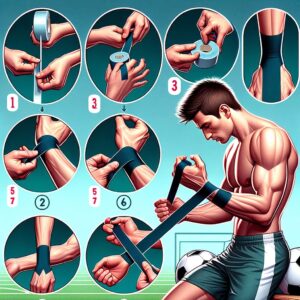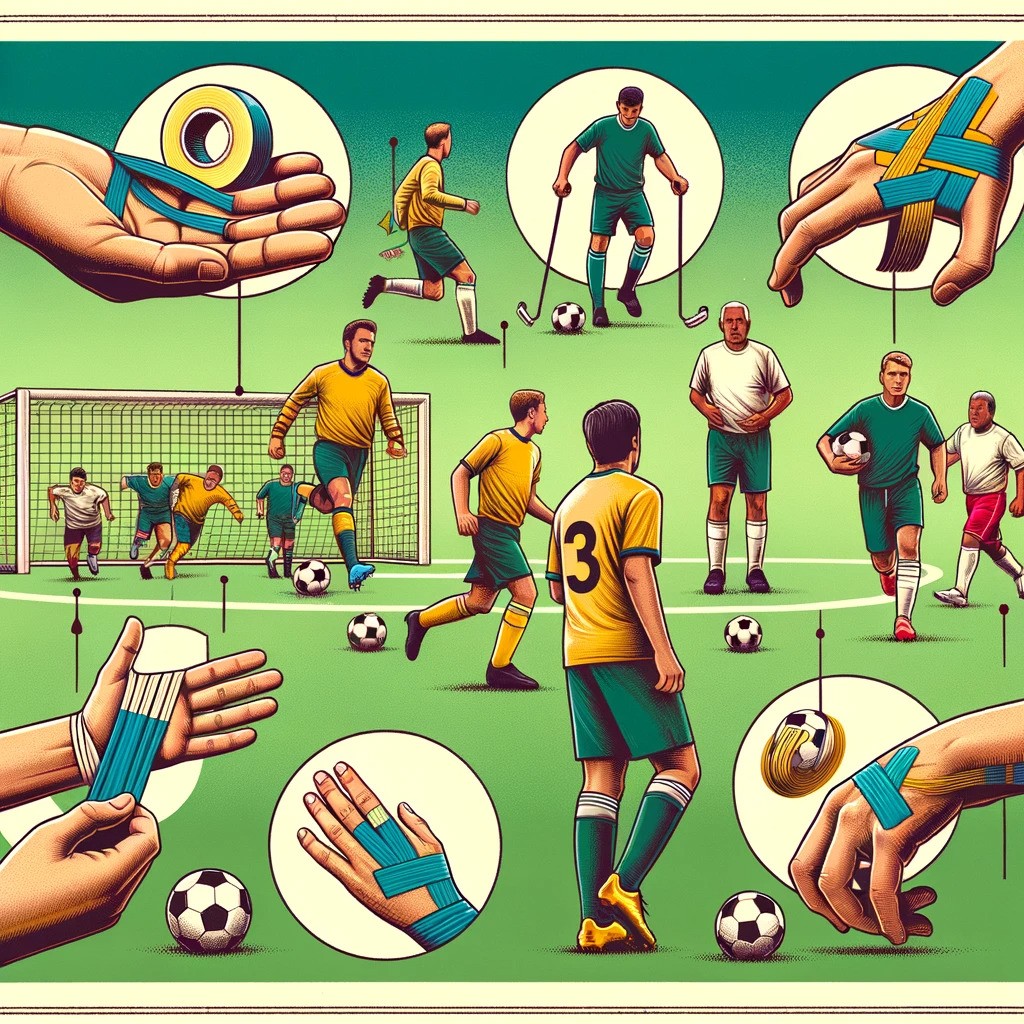As a seasoned observer of the game, I’ve noticed how footballers, both professional and amateur, often don a range of accessories. It’s not just about style; there’s more to these choices than meets the eye. In soccer, where every little edge counts, players use these items to enhance their performance and safeguard themselves against potential injury.
Imagine the intense scenario on the field – sweat dripping into eyes, disrupting focus. This is where headbands come into play, not just as a fashion statement but as a practical solution to keep vision clear. Similarly, armbands serve a dual purpose. They often display team captaincy, a symbol of leadership and responsibility, or carry a meaningful message of support. But of all these items, wrist tapes are perhaps the most intriguing.
Used by many players, wrist tapes are a common sight in football. Contrary to what some might think, their use extends beyond mere aesthetics. Taping wrists provides a sense of stability and support, crucial in a sport where hands and wrists are constantly in motion, whether for throwing ins or shielding the ball.
In the realm of football, where every small detail can influence the game, even the seemingly minor choices like wearing wrist tapes or shin guards can have significant impacts. It’s about balancing the need for personal safety with the demands of high-performance sports. Whether it’s masks in colder climates or watches for time-keeping during training, every accessory worn by a footballer has a role to play. Let’s now have a closer look why do soccer players tape their wrists.
Why do footballers wear wrist tape?
In the high-stakes world of football, every detail matters, including the accessories players choose. Wrist tape is a common sight, but its significance goes beyond aesthetics. It’s a crucial tool to protect the wrists from injury. In a contact sport like football, where players are at constant risk of getting injured through falls, collisions, or tackles, this simple accessory becomes essential.
Goalkeepers, for instance, utilize Zinc-Oxide sports tape to safeguard their fingers and wrists, even when clad in gloves. The tape offers crucial support to the digits and joints, preventing them from bending unnaturally and sustaining injuries during the rigorous nature of the game. In essence, it’s not just a piece of fabric but a protective gear crafted for the intense environment of professional soccer.
The Protective Role of Sports Tape
Moreover, sports tape acts as a protective measure for footballers in all positions, especially during sudden contact with the ball, other players, or the ground. In the event of a fall, the instinctual response is to brace oneself with the hand. By properly applying sports tape, the wrists are effectively supported and shielded from excessive bending. This practice plays a vital role in reducing the risk of injury by restricting excessive movement.
Managing Injuries
Consequently, sports tape is instrumental in managing and addressing common football injuries that may occur over the course of a match. If a player does suffer a wrist injury, wrist tape can also help to reduce swelling. It helps to compress the area and restrict blood flow, effectively aiding in reducing inflammation.
Beyond Physical Protection
Some footballers wear wrist tape for superstitious reasons. They believe that it brings them luck or helps them perform better. While there is no scientific evidence to support these claims, it’s undeniable that some players find comfort in wearing wrist tape for psychological reasons.
A Matter of Style and Preference
Finally, some footballers simply prefer the looks of wrist tape. They feel that it gives them a more professional or athletic appearance. Ultimately, the choice to wear wrist tape is a personal one. There is no right or wrong answer, and what works for one player may not work for another.
The use of wrist tape in soccer is a multifaceted decision, blending practicality, personal belief, and style. It’s a testament to how even the smallest details can have a significant impact in the world of sports.
How to Tape Your Wrists for Soccer?

When it comes to soccer, the art of taping your wrists is both straightforward and essential. This technique is not just about injury prevention; it’s a strategic addition to a player’s gear. Let’s dive into the process, ensuring your wrists are well-protected for the game.
Start by cleaning your wrists with soap and water. It’s crucial to remove any dirt or oils to prevent the tape from losing its sticking power. Cut a piece of athletic tape that’s long enough to wrap around your wrist twice. Precision in this step ensures that the tape provides the necessary support without hindrance.
Place the tape on the back of your wrist, just below your hand, and wrap it around your wrist twice. It’s essential to get this right for both comfort and effectiveness. Then, wrap the tape diagonally across your wrist, moving from the outside to the inside, and then back across, from the inside to the outside. Repeat this process until your entire wrist is covered. This diagonal wrapping technique helps distribute support evenly across the wrist.
Finish by wrapping the tape once more around your wrist, just below your hand, to secure the end of the tape. Make sure the tape is tight enough to provide support, but not so tight that it restricts your movement or circulation. After the game, remember to remove the tape carefully to avoid any skin irritation or damage. Proper removal is as important as application to ensure your skin stays healthy.
Tips and Warnings for Wrist Taping
When it comes to taping wrists for football, understanding the essential techniques and types of tapes is crucial. Not only does this practice safely support the wrist joint, but it also prevents potential damage or injury during the game. Let’s explore some tips and warnings for effective wrist taping in soccer.
Choosing the Right Tape
The most common sports tapes used in football are Athletic Tape (Zinc-Oxide) and Kinesiology Tape. Athletic Tape, being straightforward and with limited elasticity, is a good choice for short term protection and recovery. It’s wrapped around the wrist joint to limit movement, providing stability and support. On the other hand, Kinesiology Tape is highly elastic with an adhesive backing, making it a good option for athletes who wish to stay active without restricting movement.
Application Techniques
When applying the tape, whether it’s for muscle support or around a joint, ensure it’s not too tight. The tape should restrict flexibility just enough to prevent injury but not so much that it cuts off blood flow to vital areas. Different shapes and sizes of tape can be used to aid recovery from an injury.
Cohesive Bandage for Additional Support
Although Cohesive Bandage is less commonly used on wrist joints, it’s essential for the protection and support of other joints. These lightweight, flexible bandages can be wrapped around sprains and strains, providing compression to muscles and helping to reduce swelling.
Avoiding Common Mistakes
Make sure you’re not using the wrong type of tape, as this could increase the risk of further injury to a vulnerable joint. If you’re unsure, get in touch with professionals like Sterosport, who can provide you with a free sports tape sample pack and offer clear information about the features and benefits of different tapes.
Consultation for Personalized Advice
If you’re a sports rehabilitator, don’t hesitate to book a free consultation. Personalized advice can serve your specific needs best, and Sterosport’s experts are always ready to help.
Understanding Tape Features
It’s important to understand the unique features of each tape type. While some offer more flexibility, others provide firmer support. Matching the tape’s properties to your specific needs can greatly enhance its benefits.
Removing Sports Tape Safely

After a rigorous football game or a training session, it’s crucial to know the safe removal of sports tape, especially from around a joint. This step is vital to ensure there’s no further damage to the area. Experts typically recommend using blunt-nosed tape scissors to reduce the risk of injuring the player’s skin when cutting the tape. It’s a small but significant step towards maintaining skin health and avoiding discomfort post-game.
When it comes to actually pulling the tape off the body, it should be removed slowly, while applying gentle pressure to the skin close to where the tape is still adhered. This method helps to reduce tension and minimizes the risk of pulling the joint in the wrong direction.
Generally, the tape should be removed within 48 hours of its initial application, or sooner if the player complains of increased pain or irritation. It’s also important to continually monitor the taped area to ensure that blood flow has not been inhibited. Taking these precautions can make a significant difference in a player’s comfort and recovery.
When to avoid Wrist Taping
Knowing when not to use sports tape is as important as understanding how to properly tape a wrist for football. There are specific scenarios where strapping with sports tape is not recommended. For instance, if a player has circulatory or sensory problems, taping the joint might further impact these conditions. In such cases, the risks outweigh the benefits, and alternative methods should be considered.
Another critical consideration is if a player has an allergy to sports tape. The adverse reactions could hinder performance and recovery, making it counterproductive. Additionally, when a player is recovering from certain injuries, particularly fractures, it’s advisable to consult a professional sports physiotherapist. They can recommend the best protective measures tailored to the specific injury, which might not include taping.
Finally, it’s essential to understand the balance between protection and natural healing. Reducing the usage of sports tape in general activity as the injured area improves in strength and range of mobility over time is vital. It allows the area to function and heal effectively. However, reapplying sports tape to protect the injury before engaging in a high-risk activity like football is often recommended to reduce the risk of aggravating the healing area.
Conclusion
The practice of taping wrists in soccer is a multifaceted approach that combines injury prevention, support, and psychological comfort. While wrist taping offers tangible benefits like joint stability and reduced risk of aggravation, it’s crucial to understand its appropriate application, including when and how to use it effectively. Soccer players, coaches, and medical professionals must weigh the benefits against potential risks, such as allergies or impairments in circulation and sensory functions.
Frequently Asked Questions
Why do so many soccer players tape their wrists?
Soccer players tape their wrists primarily for joint stability, injury prevention, and to provide support during the game. The tape helps in restricting excessive movement that could lead to sprains or other injuries.
What is the point of wrist tape?
The main purpose of wrist tape in soccer is to stabilize the wrist joint, prevent injuries, and provide support to the area during intense physical activity. It also helps in maintaining optimal wrist alignment during play.
What does tape do for soccer players?
For soccer players, tape acts as a protective measure, offering support and stability to the wrists, which are crucial for controlling the ball and during physical challenges. It also helps in injury prevention and can aid in the recovery of minor wrist injuries.
How do you tape your wrist for soccer?
To tape your wrist for soccer, start by cleaning the area. Then, cut a length of sports tape, wrapping it around the wrist twice for stability. The tape should be snug but not too tight, ensuring support without restricting movement or circulation.
Does taping wrists help?
Yes, taping wrists can help soccer players by providing additional support, minimizing the risk of injuries, and offering stability during the game. It’s a preventive measure to guard against sprains and strains of the wrist.
Why do soccer players wear bras?
Soccer players wear what appears to be bras but are actually high-tech sports vests that hold a GPS and other monitoring devices. These vests track the player’s performance metrics, such as distance run, speed, and heart rate, providing valuable data for training and game strategies.

